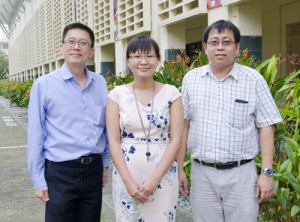Why Singapore’s English Teachers Should Embrace Singlish, Not Fight It
Is it time for Singaporean educators to embrace Singlish as a legitimate learning tool? What the Research […]
Read More
While Singapore students are among the top in the world in terms of their performance in Math, there are others who fall through the cracks and do poorly in the subject. Some do not even believe they can pass, which affect not only their grades but their future as well.
Associate Professor Toh Tin Lam, Deputy Head of the Mathematics & Mathematics Education (MME) Academic Group in NIE, believes that exploring alternative ways of teaching Math which can change students’ motivation levels and self-concept is vital in helping these “low attainers”.
Tin Lam gathered a multidisciplinary team of researchers who are specialists in education, psychology, social work and primary school Math, and worked with low-progress learners to tackle this problem together from a new angle.

(From left) Kam Ming, Lu Pien and Tin Lam are looking at students’ academic self-concept and motivation in the Math classroom.
How students view Math is important, but how students view themselves in relation to the subject is equally, if not more important. This is termed academic self-concept in Math. Associate Professor Lim Kam Ming from Psychological Studies in NIE shares that self-concept is important because it is linked to the students’ motivation to perform in the subject, which, in turn, impacts their self-efficacy.
“Self-efficacy refers to a student’s belief in their ability to succeed in something,” Kam Ming explains. “Research has shown that self-efficacy has long-term impact because that belief may affect other spheres in their life, including higher education aspirations and even career choices.”
If students have low self-efficacy in Math, they do not believe they can do well and will lack motivation to try harder. As a result, they find themselves caught in an unfortunate cycle detrimental to their academic self-concept.
Because of this, Kam Ming stresses we need to look at students’ academic self-concept and motivation as early as possible. This applies not just for Math, but for all school subjects.
For Tin Lam’s project, his team of researchers is specifically looking at Secondary 1 Normal (Technical) Math students. His NIE colleague Assistant Professor Cheng Lu Pien notes that this is an important time for these students.
“At this point, the students are trying to adjust to a secondary school system after graduating from primary school,” explains Lu Pien. “Thus, there is a need to help the students draw connections between the primary and secondary Math curriculum, so they can appreciate how they’re not completely clueless and what they’re learning is built upon their prior knowledge.”
The team first did a survey on how NT teachers engage their low-attaining students.
“We saw that storytelling and use of humour, drama and comics consistently occur in the teachers’ responses, but there is a lack of concerted effort to develop such materials and monitor the impact of these less traditional approach on students’ self-concept, motivation and mathematical competency,” Tin Lam notes. “This led to the conceptualization of this project.”
The project just started in December 2014 but the team has already created resources for two topics: algebra and statistics.
(Students) are motivated because they sense they can take charge of their learning, they know they’re able to do it, and they are able to experience their successes along the way.
– Lim Kam Ming, Psychological Studies Academic Group
Storytelling and comics can possibly pique students’ interest and make them more receptive towards Math. More importantly, these alternative approaches reshape the passive role of the learner into something more.
“For example, storytelling involves role playing. By being involved, the student changes his or her perspective in terms of motivation to learn,” Kam Ming shares. “They are motivated because they sense they can take charge of their learning, they know they’re able to do it, and they are able to experience their successes along the way.”
Tin Lam and his team hope to develop these pedagogies into a systematic package, which will potentially be beneficial for not only Math teachers, but also generalized to other subjects.
“The results will tell us whether or not there is an opportunity to use this strategy, or whether there are areas that need to be improved or changed,” Kam Ming adds. “That would strengthen the literature understanding and the research area in terms of what are the aspects of the pedagogy that works.”
Lu Pien echoes his sentiments. She says that they need to know what works, and also why it works. “The package may be considered novel to some children, but in the long term, it would be useful to also investigate what it is exactly about these pedagogies that sustain the students’ interest and motivation.”